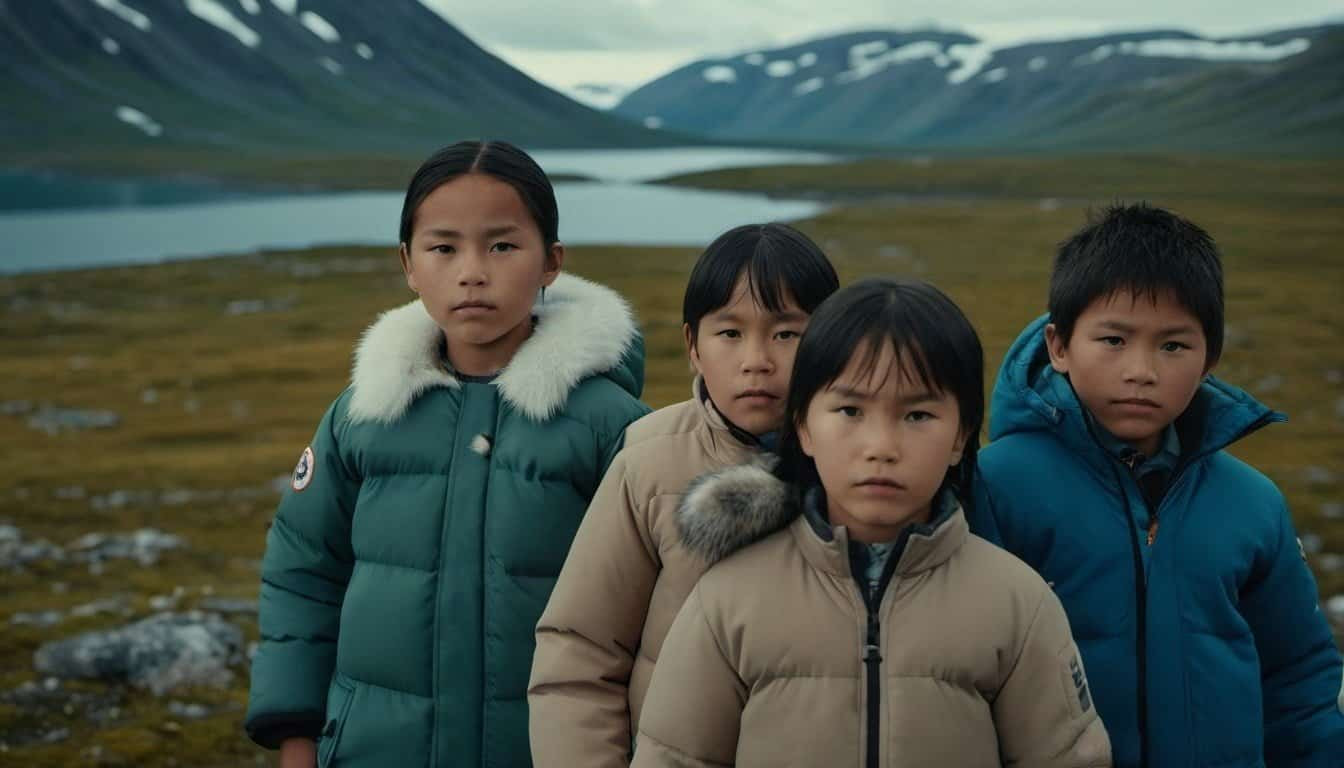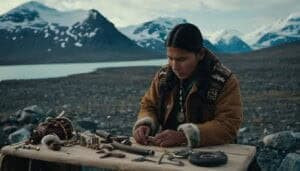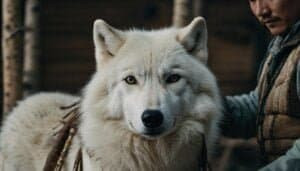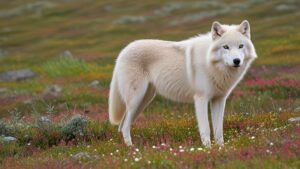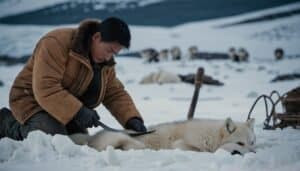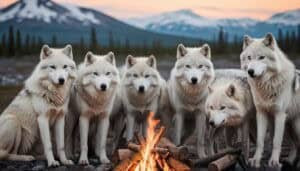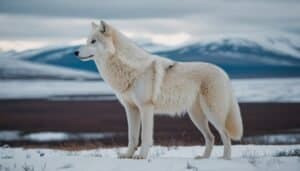Introduction
Arctic wolves hold a significant place in the lives and educational practices of Arctic children. These majestic creatures are deeply intertwined with the cultural, environmental, and practical learning experiences of indigenous communities
This article explores the multifaceted ways in which Arctic wolves influence the education of Arctic children, from traditional storytelling and cultural significance to environmental observation and survival skills
We will delve into how these wolves help shape language, communication, emotional development, and community roles, providing a comprehensive understanding of their impact on Arctic education
Traditional and Cultural Education
Arctic wolves have long been a part of the cultural fabric of Arctic communities, influencing traditional and cultural education for Arctic children. These wolves are not just animals to be observed from a distance; they are woven into the stories, practices, and traditions passed down through generations
This section explores the role of Arctic wolves in folklore, mythology, cultural significance, heritage, and community practices
Folklore and Mythology
In many Arctic cultures, folklore and mythology feature Arctic wolves prominently. These stories serve as a means to convey moral lessons, cultural values, and survival strategies
For instance, Inuit legends often portray wolves as wise and powerful beings, embodying traits such as loyalty, bravery, and cunning. These stories are shared through oral traditions, with elders recounting tales to younger generations during long winter nights
The stories about wolves often include lessons about cooperation and resilience. One common tale might describe how a lone wolf cannot survive without its pack, teaching children the importance of community and working together
Another story might highlight a wolf’s journey through harsh conditions, emphasizing perseverance and adaptability, crucial traits for surviving in the Arctic environment
Cultural Significance
Arctic wolves hold a revered place in the cultural identity of many Arctic peoples. They symbolize various attributes such as strength, endurance, and wisdom. This cultural significance is reflected in the art, clothing, and rituals of Arctic communities
Wolf imagery can be found in carvings, embroidery, and ceremonial garments, serving as a constant reminder of the animal’s importance
Children learn about the symbolic meanings of wolves through participation in cultural practices and ceremonies. For instance, during certain festivals or rites of passage, the stories and significance of the wolf are highlighted, reinforcing the connection between the animal and the community’s identity. These practices help instill a sense of pride and continuity in cultural heritage among the younger generation
Heritage and Tradition
Heritage and tradition are critical components of Arctic education, and Arctic wolves are central to these elements. The transmission of knowledge about wolves, their behavior, and their role in the ecosystem is a key aspect of cultural heritage. Elders often teach children how to track wolves, understand their patterns, and respect their territory
These teachings are not just about the wolves themselves but also about broader themes of respect for nature and the interconnectedness of all living things
Children are taught to observe and learn from the wolves, gaining insights into survival tactics that can be applied to their own lives. This form of education ensures that traditional knowledge is preserved and passed down, maintaining the community’s connection to its environment and history
Community Practices
Community practices often involve interactions with Arctic wolves, providing practical and educational experiences for Arctic children. These practices include hunting, tracking, and understanding the wolves’ impact on the local ecosystem. By participating in these activities, children learn essential skills and gain a deeper appreciation for their environment
For example, during hunting expeditions, children observe how wolves hunt and strategize, learning valuable lessons about patience, strategy, and the importance of each member’s role in a successful hunt. Community hunts often include storytelling and sharing of experiences, where children hear firsthand accounts of wolf encounters and the lessons learned from them
In addition to hunting, community practices might involve rituals and ceremonies that honor the wolf
These events provide a platform for elders to share their wisdom and for children to engage in cultural expressions that reinforce their connection to the wolf and the natural world. These practices help children understand the wolf’s role within the ecosystem and the cultural context, fostering a holistic view of their environment
Through folklore, mythology, cultural significance, heritage, and community practices, Arctic wolves play a crucial role in the traditional and cultural education of Arctic children. These elements not only teach practical skills and knowledge but also instill a deep respect for nature and cultural identity, ensuring that the values and traditions of Arctic communities are preserved and celebrated
Environmental and Observational Learning
Arctic wolves play a pivotal role in the environmental education of Arctic children. By observing these majestic animals, children learn about the complex relationships within their ecosystem, the importance of biodiversity, and the skills necessary for survival in a harsh environment
This section delves into how Arctic wolves contribute to wildlife observation, ecosystem understanding, tracking techniques, and behavioral studies
Wildlife Observation
Arctic children often engage in wildlife observation as a part of their learning process, with Arctic wolves being one of the key species studied
Observing wolves in their natural habitat helps children develop keen observational skills and a deep appreciation for the intricate balance of the ecosystem. This hands-on learning experience is crucial in teaching children how to recognize animal behaviors, identify tracks, and understand the dynamics of predator-prey relationships
Through guided excursions led by elders or experienced hunters, children learn to patiently observe wolf packs from a distance, noting their social structure, hunting strategies, and interactions with other species. These observations provide valuable insights into the wolves’ role within the Arctic ecosystem and highlight the importance of each species in maintaining ecological balance
Ecosystem Understanding
Understanding the role of Arctic wolves within the ecosystem is a vital component of environmental education for Arctic children
Wolves are apex predators, and their presence or absence can significantly impact the population dynamics of other species and the overall health of the ecosystem. By studying wolves, children learn about trophic cascades and the interdependence of different species
For instance, the presence of wolves can control the population of herbivores such as caribou and hares, which in turn affects the vegetation and the availability of resources for other animals. This top-down regulation helps maintain biodiversity and ecosystem stability
Children learn about these complex interactions through both direct observation and community teachings, gaining a holistic understanding of their environment
Tracking Techniques
Tracking is an essential skill taught to Arctic children, and Arctic wolves provide a perfect subject for honing these abilities. Tracking wolves involves understanding their movement patterns, recognizing their tracks, and interpreting signs such as scat, fur, and markings
These skills are not only important for hunting but also for general wildlife monitoring and safety
Children learn to distinguish between different types of tracks and to follow them over various terrains. This practice enhances their spatial awareness, critical thinking, and problem-solving skills. Elders often accompany children on tracking expeditions, sharing their knowledge and experience to help the younger generation develop a deep connection to the land and its inhabitants
Behavioral Studies
Studying the behavior of Arctic wolves offers profound insights into the social dynamics and survival strategies of these animals
Arctic children learn about wolf pack hierarchy, communication methods, and cooperative hunting techniques. These studies are usually conducted through direct observation, guided by the teachings of community elders and hunters
Understanding wolf behavior helps children appreciate the complexity of animal societies and the importance of teamwork and cooperation. For example, children observe how wolves communicate through vocalizations, body language, and scent marking. They learn how pack members work together to hunt and raise their young, drawing parallels to their own community practices and the value of collaboration
Behavioral studies also emphasize the adaptability of wolves to changing environmental conditions
Children see firsthand how wolves adjust their hunting strategies, social structures, and territories in response to factors like prey availability and climate change. These observations reinforce lessons about resilience and adaptability, which are crucial for survival in the Arctic environment
Through wildlife observation, ecosystem understanding, tracking techniques, and behavioral studies, Arctic wolves provide a comprehensive framework for environmental and observational learning
This education not only equips Arctic children with essential survival skills but also fosters a deep respect for nature and an understanding of the intricate relationships that sustain their ecosystem
Practical Skills and Survival Training
In the Arctic environment, practical skills and survival training are essential for daily life. Arctic wolves, with their remarkable adaptation to the harsh conditions, serve as an inspiration and a model for learning these skills
This section explores how Arctic wolves influence the teaching of hunting techniques, navigational skills, physical fitness, and outdoor exploration to Arctic children
Hunting Techniques
Hunting is a critical survival skill in Arctic communities, and Arctic wolves are exemplary hunters. By studying wolf hunting techniques, children learn strategies that enhance their own hunting proficiency
Wolves are known for their cooperative hunting strategies, where pack members work together to track, encircle, and take down prey. This collective effort teaches children the importance of teamwork and coordination
Children often accompany adults on hunting trips where they observe wolves in action or follow wolf tracks to find prey
They learn how to interpret signs of wolf activity, such as tracks, scat, and kill sites, to understand where prey animals might be found. These experiences are invaluable, providing practical lessons in stealth, patience, and the use of natural resources
Navigational Skills
Navigating the vast and often featureless Arctic landscape requires excellent spatial awareness and an understanding of natural cues. Arctic wolves, which travel long distances across the tundra, exhibit remarkable navigational abilities
By studying wolf movements and territories, Arctic children learn essential navigational skills
Tracking wolves involves reading the landscape, understanding the terrain, and recognizing environmental markers. Children are taught to use natural features like the position of the sun, the shape of the land, and even the growth patterns of vegetation to orient themselves
These skills are crucial for finding one’s way and ensuring safety in the Arctic wilderness
Physical Fitness
The physical demands of living in the Arctic require a high level of fitness, and observing the stamina and endurance of Arctic wolves provides motivation for children to develop their own physical capabilities. Wolves cover vast distances in search of food, demonstrating endurance, speed, and strength
Children engage in activities that mimic the movements and challenges faced by wolves. This might include running over snowy terrain, practicing stealth in hunting simulations, and learning to move efficiently through the landscape
These physical exercises are not only practical but also help build strength, agility, and cardiovascular health, preparing children for the physical challenges of their environment
Outdoor Exploration
Outdoor exploration is a fundamental part of Arctic life, and Arctic wolves encourage a spirit of curiosity and discovery
By following wolf tracks and exploring their habitats, children learn to appreciate the natural world and gain practical skills for survival. This exploration fosters a connection to the land and an understanding of its resources
Children are encouraged to explore different environments, from frozen tundra to dense forests, learning about the diverse habitats and the wildlife that inhabit them. This exploration is guided by elders and experienced hunters who teach children how to observe wildlife, identify plants, and understand the seasonal changes that affect their surroundings
These outdoor adventures also emphasize safety and preparedness. Children learn to recognize signs of changing weather, understand the risks of different terrains, and carry essential survival gear. This practical knowledge is critical for thriving in the Arctic environment and is deeply influenced by the adaptive strategies observed in Arctic wolves
Through the teaching of hunting techniques, navigational skills, physical fitness, and outdoor exploration, Arctic wolves play a vital role in the practical skills and survival training of Arctic children. These lessons ensure that the younger generation is well-equipped to face the challenges of their environment while fostering a deep respect for the natural world and its inhabitants
Language, Communication, and Emotional Development
Language, communication, and emotional development are integral aspects of Arctic children’s education, with Arctic wolves serving as powerful symbols and practical examples
The presence of wolves in Arctic culture influences storytelling practices, linguistic development, emotional resilience, and the connection to nature. This section explores how these elements are interwoven into the educational practices of Arctic communities
Storytelling Practices
Storytelling is a cornerstone of Arctic education, and Arctic wolves frequently feature in these narratives. Through stories, children learn about their culture, history, and the natural world
These tales often carry moral lessons, survival tips, and cultural values, with wolves embodying various characteristics that are admired or warned against
Inuit stories, for instance, may portray wolves as clever and resourceful, teaching children the importance of ingenuity and adaptability. These stories are shared in communal settings, such as during long winter nights around a fire, fostering a sense of community and continuity
Elders use these stories to engage children’s imaginations, teach critical thinking, and pass down traditional knowledge
Linguistic Influence
The Arctic wolves’ role in storytelling and cultural practices also influences the linguistic development of Arctic children
Many indigenous languages of the Arctic have specific terms and phrases related to wolves, their behaviors, and their environment. Learning these terms is part of understanding the broader ecological and cultural context
For example, the Inuktitut language has words that describe the various ways wolves move, hunt, and interact with their environment. Children learn these terms as they engage in tracking and observing wolves, enriching their vocabulary and deepening their understanding of the language
This linguistic richness helps preserve the language and ensures that traditional knowledge is conveyed accurately
Connection to Nature
Arctic wolves symbolize the deep connection that Arctic peoples have with their natural environment
This connection is crucial for the emotional development of Arctic children, who learn to see themselves as part of a larger ecological system. Observing and interacting with wolves fosters a sense of wonder and respect for nature, promoting a holistic view of life
Children are taught to observe the behavior of wolves and other animals, recognizing that these creatures share the same environment and resources. This understanding nurtures empathy and a sense of responsibility toward the environment. By seeing how wolves adapt and thrive, children learn valuable lessons about resilience and the importance of living in harmony with nature
Emotional Resilience
Living in the harsh Arctic environment requires emotional resilience, and Arctic wolves provide a powerful model for this trait. Wolves are highly adaptable, enduring extreme weather conditions and scarcity of food. By observing wolves, children learn about perseverance, adaptability, and coping with adversity
Community teachings often include stories of wolves overcoming challenges, which serve as metaphors for human experiences
These stories help children understand that struggles are a natural part of life and that resilience is essential for survival. Elders and parents use these examples to teach children how to manage their emotions, stay calm under pressure, and find strength in difficult times
Additionally, the bond between wolves and their pack members illustrates the importance of social support and cooperation. Children learn that, like wolves, they can rely on their family and community for support during tough times
This lesson is crucial for building strong, supportive relationships and fostering a sense of belonging and security
Through storytelling practices, linguistic development, connection to nature, and emotional resilience, Arctic wolves significantly influence the language, communication, and emotional development of Arctic children. These elements not only preserve cultural heritage but also equip children with the skills and mindset needed to thrive in their unique environment
Educational Structures and Community Roles
Arctic wolves play a crucial role in shaping the educational structures and community roles within Arctic communities
These educational frameworks integrate traditional knowledge, practical skills, and cultural teachings, ensuring that children receive a well-rounded education. This section examines the role of Arctic wolves in school curriculums, community workshops, elders’ teachings, and mentorship and guidance
School Curriculums
Incorporating Arctic wolves into school curriculums helps bridge traditional knowledge with formal education
Many schools in Arctic regions include lessons about wolves in subjects like biology, ecology, and cultural studies. These lessons provide students with a comprehensive understanding of the natural world and their cultural heritage
For example, biology classes may cover the anatomy, behavior, and ecological role of Arctic wolves, while cultural studies explore the significance of wolves in local folklore and traditions
Field trips and outdoor activities often involve observing wolves or their tracks, giving students hands-on experience that reinforces classroom learning. This integration of traditional and formal education helps students appreciate the relevance of their cultural knowledge in modern contexts
Community Workshops
Community workshops are an essential aspect of Arctic education, offering opportunities for hands-on learning and the exchange of traditional knowledge
Workshops led by hunters, elders, and conservationists often focus on Arctic wolves, teaching children practical skills such as tracking, hunting techniques, and ecological stewardship
These workshops provide a platform for intergenerational learning, where children learn directly from experienced community members. Participants might engage in activities like crafting tools for tracking wolves, creating traditional wolf-related art, or discussing the ecological impact of wolf populations
This collaborative learning environment strengthens community bonds and ensures the preservation of cultural practices
Elders’ Teachings
Elders hold a revered position in Arctic communities, serving as the primary custodians of traditional knowledge and cultural practices
Their teachings about Arctic wolves are invaluable, encompassing a wealth of information that spans generations. Elders share stories, observations, and practical advice, helping children understand the deep connections between their culture and the natural world
These teachings often occur in informal settings, such as family gatherings or community events, where elders recount their experiences with wolves and other wildlife. Through these stories, children learn about respect for animals, the importance of balance in the ecosystem, and the ethical considerations of hunting and resource use
Elders also teach children about the spiritual significance of wolves, reinforcing their role in cultural and community life
Mentorship and Guidance
Mentorship and guidance are critical components of Arctic education, with experienced hunters and community leaders playing a significant role in the upbringing of children. These mentors provide practical training in survival skills, often using Arctic wolves as a reference point for teaching techniques such as tracking, hunting, and navigation
Mentors accompany children on excursions into the wilderness, demonstrating skills and offering insights into the behavior and ecology of wolves
This hands-on guidance helps children develop confidence and competence in their abilities. Mentors also emphasize the ethical and cultural dimensions of interacting with wildlife, ensuring that children grow up with a balanced perspective that values both survival and sustainability
Mentorship programs often include formal and informal elements, ranging from structured apprenticeships to casual learning experiences. These programs help children build a strong foundation of skills and knowledge, preparing them for future roles within their communities. By learning from their mentors, children gain a sense of identity and continuity, connecting them to their cultural heritage and community values
Through school curriculums, community workshops, elders’ teachings, and mentorship and guidance, Arctic wolves significantly influence the educational structures and community roles in Arctic regions
These educational frameworks ensure that children receive a holistic education that blends traditional knowledge with practical skills, fostering a deep respect for their culture and environment
Conclusion
Arctic wolves play a multifaceted role in the education of Arctic children, influencing various aspects of their learning and development. Through traditional stories and cultural education, wolves help preserve the rich heritage and values of Arctic communities
Environmental and observational learning, guided by the behavior and ecology of wolves, equips children with a deep understanding of their ecosystem and enhances their practical skills for survival
In the realm of practical skills and survival training, Arctic wolves serve as models for teaching essential techniques such as hunting, navigation, and physical endurance. The influence of wolves extends to the language, communication, and emotional development of Arctic children, where storytelling practices and direct observation foster a connection to nature and build emotional resilience.
Educational structures and community roles are also shaped by the presence of Arctic wolves, with school curriculums, community workshops, elders’ teachings, and mentorship programs integrating wolf-related knowledge and practices. These educational frameworks ensure that Arctic children receive a holistic education that respects and preserves their cultural heritage while preparing them for the challenges of their environment
Overall, the relationship between Arctic wolves and Arctic children is one of deep cultural significance and practical importance, highlighting the interconnectedness of nature and human life in the Arctic regions
